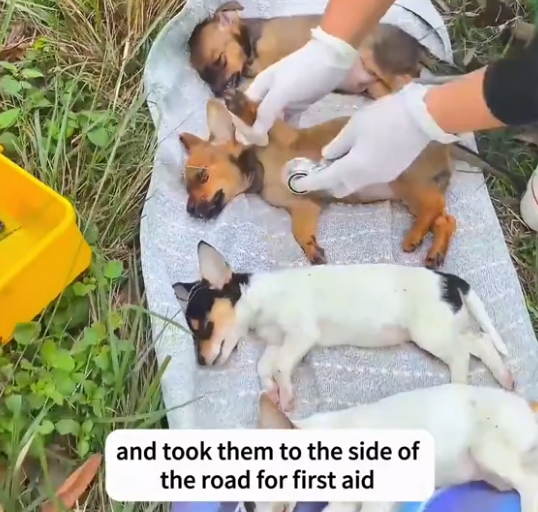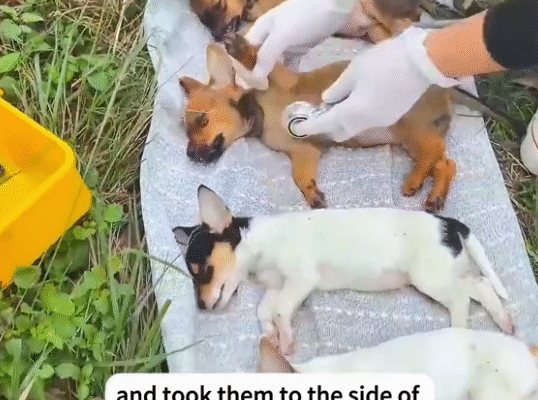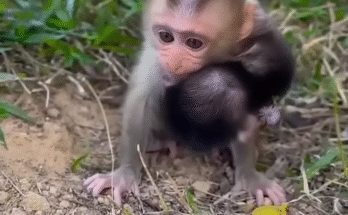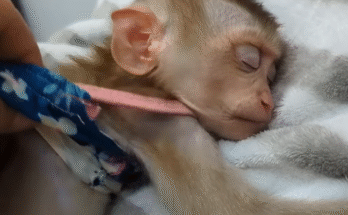It was an ordinary afternoon in a quiet suburban neighborhood when everything suddenly changed. The sky was overcast, and the gentle breeze made the trees sway. Children were playing in the park, neighbors chatted over fences, and dogs barked in distant yards. But the peace was shattered by a sudden screech of tires, followed by panicked shouting.
A delivery truck had lost control while avoiding a cyclist, veering off the road and crashing through a fence that separated the street from a small, makeshift animal shelter run by local volunteers. Behind that fence were several kennels housing rescued animals—among them, a litter of five-week-old puppies and their mother.
The impact of the crash was enough to send debris flying across the yard. A piece of the metal gate struck one of the puppy pens, sending fragments of wood and wire into the area. The mother dog barked frantically, trying to shield her babies, but a few of the puppies were hit by splinters and flying debris. The shelter manager, Maria Gomez, had just stepped outside to feed the animals when she witnessed the horrifying scene.
Maria, a retired veterinary nurse, rushed into the pen without hesitation. “My heart was pounding,” she later recounted. “All I could think about was those tiny puppies.” She quickly assessed the situation: two of the puppies were bleeding, one had trouble breathing, and another appeared unconscious. The mother dog was uninjured but visibly shaken, pacing around her injured pups with worry in her eyes.

Within minutes, Maria called for help, and the local volunteer emergency response group for animals arrived—an organization known as P.A.W.S. (Protect Animals With Support). These trained volunteers were used to responding to crises involving animals, from house fires to floods, but even they weren’t prepared for the chaos of the scene.
As the team arrived, they brought emergency first-aid kits, portable oxygen tanks, stretchers, and warm blankets. Their goal was simple: stabilize the puppies and transport them to the nearest animal hospital for further care.
Emma, a young veterinary student volunteering with P.A.W.S., took charge of administering first aid. She gently cradled the unconscious puppy, checking for a pulse and signs of breathing. “It’s barely breathing,” she whispered, quickly beginning CPR—tiny chest compressions with two fingers, and small puffs of air into the puppy’s nose.
Meanwhile, Jake, another volunteer, tended to the two bleeding puppies. He cleaned the wounds using sterile saline and applied antibiotic ointment to prevent infection. They wrapped the tiny legs in soft gauze to keep them immobilized. “We knew time was critical,” Jake said. “Every second counted.”
Back inside the animal rescue van, which had been converted into a mobile emergency unit, Emma carefully placed the unconscious pup inside a small oxygen chamber. With the help of a warming pad and constant monitoring, the pup began to show signs of recovery—its shallow breaths becoming steadier, its tiny chest rising and falling with a rhythm of hope.
The mother dog, still shaken, was kept nearby so she could see her babies. Her presence helped calm them, her whimpers met with faint squeaks from the recovering pups.
The emergency team quickly transported all five puppies and their mother to the local veterinary clinic. Dr. Patel, the lead vet on call, greeted them at the door. “We had already received the call from Maria and prepared an emergency suite,” he explained.
One by one, the puppies were examined. The one who had been unconscious suffered a mild concussion but no brain trauma. The two with wounds were treated and stitched up, and the others received fluids and a thorough examination. “They’re fighters,” Dr. Patel remarked. “They’re small, but they have strong hearts.”
News of the incident quickly spread across social media. The shelter posted an update about the crash and the heroic rescue, along with photos of the puppies receiving care. Messages of support poured in from the community, along with donations to help with medical costs.
Over the next few days, the puppies remained under close observation. Volunteers visited them daily, helping them recover with gentle play, soft food, and lots of love. The mother dog never left their side, licking their faces and snuggling close to keep them warm.
Maria couldn’t hold back tears when the unconscious puppy—nicknamed “Lucky”—finally opened his eyes and wagged his tiny tail. “That moment made everything worth it,” she said. “We didn’t know if he would make it, but he did.”
The driver of the truck was also shaken but uninjured. He came to visit the shelter a few days later and offered his apologies, along with a generous donation. “I didn’t see the cyclist until the last second,” he said. “I swerved to avoid him and didn’t even realize there was a shelter there. I’m just glad everyone is okay.”
In the aftermath of the incident, the shelter began a campaign to improve safety measures around the property. Local authorities pledged support to build a stronger fence and add warning signs for passing traffic. Volunteers organized a fundraising event called “Puppy Strong,” where families came to meet the rescued dogs, play games, and donate to help improve the shelter.
A month after the crash, the puppies were fully recovered and ready for adoption. One by one, they found loving homes—some with the very volunteers who had helped save their lives. Lucky, the pup who had almost died, was adopted by Emma, the vet student who gave him CPR. “I couldn’t let him go,” she said. “He stole my heart.”
The story of the emergency rescue and first aid given to the puppies became a symbol of compassion and community. It reminded people how quickly things can change, and how important it is to be prepared, to act fast, and to never underestimate the power of love and teamwork.
From tragedy came a tale of survival. These puppies, once injured and vulnerable, were now thriving thanks to the bravery of a few dedicated individuals who refused to give up on them. And in a world where bad news often dominates the headlines, their story was a shining example of hope, kindness, and the incredible bond between humans and animals.



